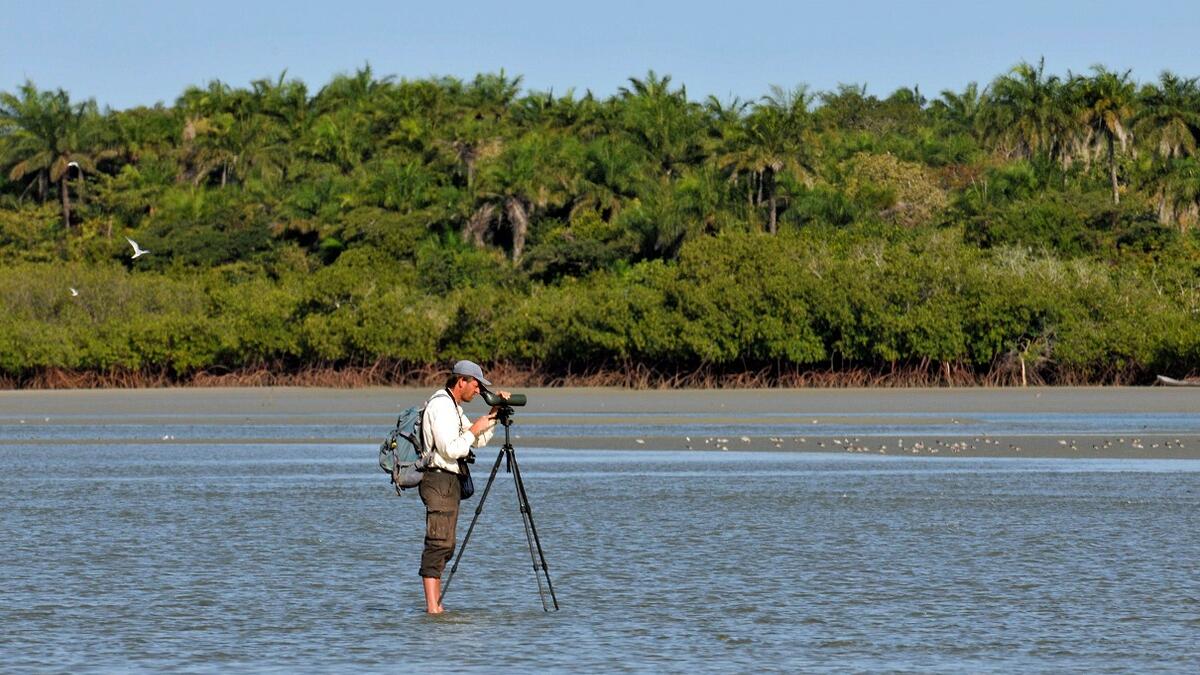
Photo: Lars Malta Rasmussen. Bird watching in Guinea Bissau.
East Atlantic Flyway
M. van Roomen, G. Agblonon, G. Citegetse, O. Crowe, T. Langendoen, S. Nagy, H. Schekkerman, & E. van Winden
Published 2022
1. Introduction
The Wadden Sea is well known for the occurrence of huge numbers of breeding, migrating and wintering waterbirds. This is one of the main aspects contributing to the Wadden Sea’s Outstanding Universal Value for which it has been designated as a World Heritage site (Reise et al., 2010). However, as most of these waterbird species are migratory, for them the Wadden Sea is only one site in a network of sites along the eastern shores of the Atlantic Ocean and adjacent seas usually referred to as the East Atlantic Flyway (Figure 1). Depending on their migration patterns, individual birds and the populations they belong to often use a large part of this network of sites, in addition to the Wadden Sea itself. Hence, the populations of the species occurring in the Wadden Sea will also be influenced by the conditions at sites elsewhere. Therefore, important baseline information (numbers, trends, pressures) for the management and conservation of migratory Wadden Sea birds also needs to be collected at these other sites. This baseline information is informing us about the importance of these sites, possible changes in site quality and possible causes of these changes. Total population sizes and trends from the whole flyway (numbers and trends of the different sites combined) are also needed to provide context to the knowledge of the Wadden Sea itself. It enables answering questions like “how much of the flyway population makes use of the Wadden Sea”, “is the trend in the Wadden Sea different from what we find in the flyway or not and can we link this to better or worse conditions within the Wadden Sea” (see Koffijberg et al., thematic report Breeding Birds, see Kleefstra et al., thematic report Migratory Birds).
The fact that bird populations within the Wadden Sea are also influenced by conditions elsewhere along the flyway formed the rationale behind the establishment of the Wadden Sea Flyway Initiative (WSFI). This initiative was launched after the recognition of the Wadden Sea as a World Heritage site, aiming for improved cooperation, knowledge exchange and management along the flyway. From the start, a monitoring programme was initiated (van Roomen et al. 2015, 2018, 2022). The results of the flyway monitoring programme are the focus of this thematic report. The monitoring is carried out through a cooperation between WSFI, Wetlands International and BirdLife International. Since 2013, annual counts of birds have been carried out in January and environmental conditions were registered at a selection of sites in Western Africa, in addition to what was already done in Western Europe. In 2014, 2017 and 2020, so-called ‘total’ counts were organized, aiming to cover all important sites along the flyway “from Norway to South Africa”, and flyway assessment reports were prepared (van Roomen et al. 2015, 2018 & 2022). Results obtained in 2013-2020 were compared with older counts from Western Europe starting in the 1970s and more sporadic counts around 1980 and 2000 from Western Africa. Also, in addition to the January counts, results from breeding bird monitoring were used in the assessments.
This thematic report provides a summary of the trends in bird numbers, distribution patterns and pressures along the flyway. It is an update of the first Quality Status Report (QSR) report about the flyway (van Roomen et al. 2017). Updates of the trends in the populations of breeding birds in the Wadden Sea and in the numbers of migratory birds in the Wadden Sea in comparison with flyway trends are given in the separate QSR reports on Breeding Birds and Migratory Birds.
 Figure 1. The East Atlantic Flyway. Birds from the Arctic (in orange) breeding between Siberia and Northeast Canada use sites (blue dots) along the Eastern shore of the Atlantic Ocean and connect these during migration and wintering. At these sites they mix up with breeding populations both from Western Europe and Western Africa which also migrate and winter at these sites (Image CWSS).
Figure 1. The East Atlantic Flyway. Birds from the Arctic (in orange) breeding between Siberia and Northeast Canada use sites (blue dots) along the Eastern shore of the Atlantic Ocean and connect these during migration and wintering. At these sites they mix up with breeding populations both from Western Europe and Western Africa which also migrate and winter at these sites (Image CWSS).
2. Status and trends
2.1. Methods
Species and populations
The East Atlantic Flyway monitoring includes waterbird species and populations which make use of the Wadden Sea and often generally occur at coastal sites. However, other Palearctic - and Afrotropical populations occur at these sites as well and these populations are also included in the monitoring as they form an integral part of the waterbird fauna of the sites under investigation. Annex 1 lists the species and populations for which flyway trends are calculated and indicates whether they make use of the Wadden Sea to a great extent (more than 5% of their flyway population), to a lesser extent (less than 5%), or constitute a Palearctic or Afrotropical population that does not occur in the Wadden Sea during any part of their annual cycle.
Flyway population trends
Flyway trends are calculated based on counts of either breeding or wintering birds (Nagy et al., 2021). For flyway trends based on wintering numbers, the International Waterbird Census (IWC) is used (Nagy & Langendoen, 2020), augmented by dedicated monitoring programmes for geese (EGMP, 2021; WWT, 2021). For flyway trends based on breeding bird data, data were taken from the Pan-European Common Bird Monitoring Scheme (PECBMS) or the EU art.12 Birds Directive and European Red List monitoring (Brlík et al., 2021; BirdLife International, 2021). Trends are based on the count data from sites within the population-specific flyway distribution boundaries. Trends are calculated both over a long term (mostly the period 1975 – 2020) and for a recent ten-year period (mostly 2011-2020). Details of the methods of trend calculation and analysis are described in Nagy & Langendoen, 2020; van Roomen et al., 2018; Wetlands International, 2020. Classification of trends follows Soldaat et al., 2007. Trends and additional information for each population included in this analysis are summarised in Annex 1. This includes whether trends are based on wintering or breeding bird data, whether population-specific flyway boundaries are well established or less certain, and the exact time periods for the long- and short-term trends.
Importance of winter sites for Wadden Sea populations
Based on the winter census data, five-year mean numbers in January 2016 – 2020 were calculated for sites. Sites are logical ecological and geographical units that often match Natura 2000, Ramsar or Important Bird Area site boundaries. From this dataset, flyway populations occurring to a great extent in the Wadden Sea (Annex 1) have been selected (in this report referred to as ‘important Wadden Sea populations’) and compared with their total flyway population size (Wetlands International, 2021). The resulting percentages of each flyway population occurring at that site were summed to get an indication of the overall importance of sites (called estimated aggregated site importance) for Wadden Sea populations in winter (method based on Harebottle & Underhill, 2016).
Pressures to birds at important sites
As part of the East Atlantic Flyway monitoring, questionnaires were sent out to observers to gather information on pressures at the surveyed sites (van Kleunen et al., 2018; BirdLife international, 2006). Observers and local site managers were asked to jointly come to a consensus and fill in the questionnaires. These were then validated by national coordinators and by the organizers of the flyway monitoring. In the questionnaire, each possible pressure was scored for occurrence (absent, occurring presently, took place in the past but no more, or will likely happen in the future (within five years)), spatial scope (affecting the whole site, most of the site, or some small part) and severity (rapid, moderate or slow impact) or could be marked as unknown. Scores for the three criteria were taken together into an overall score of pressure. Filled in questionnaires are available for 115 sites along the coastal East Atlantic Flyway, including the most important wintering sites.
2.2. Trends of flyway populations
Based on either wintering or breeding bird data updates of flyway trends were calculated for 81 relevant populations of 67 species. Examples of these trends are given in Figure 2. The species included in Figure 2 represent flyway populations for which the Wadden Sea is an important site (e.g. Brent Goose, Eurasian Wigeon, Pied Avocet and Bar-tailed Godwit), other Palearctic populations not using the Wadden Sea (e.g. the schinzii subspecies of Dunlin breeding in Iceland) and Afro-tropical populations (e.g. Lesser Flamingo breeding in West Africa). For the majority of the species and populations, the trends are favourable in the long term and short term. Far fewer populations are declining (Figure 3). Summarising the trends according to the breeding region of the populations involved shows that on average populations breeding in the Arctic are declining while populations breeding in temperate, Mediterranean and African regions are on average stable (Figure 4). Of course, within each category individual populations may deviate from the average (Annex 1). Compared with a previous analysis (for the period 2008 – 2017) described in Schekkerman et al. (2018), the present pattern is similar although fewer North-temperate and Mediterranean populations show an increase in the present analysis. When differentiating between flyway populations that are important in the Wadden Sea and populations that are not, no large differences were found in trends between populations that heavily rely on the Wadden Sea, or those that do not (Figure 5). In the past, particularly populations that rely to a large extent on the Wadden Sea were described to be often decreasing (van Roomen et al., 2015). In our current analysis that seems no longer to be the case, although some Wadden Sea important populations still show decreases (Figure 6). Remarkable are the recent declines in Sanderling and Bar-tailed Godwit (lapponica population), which follow after long periods of increase.
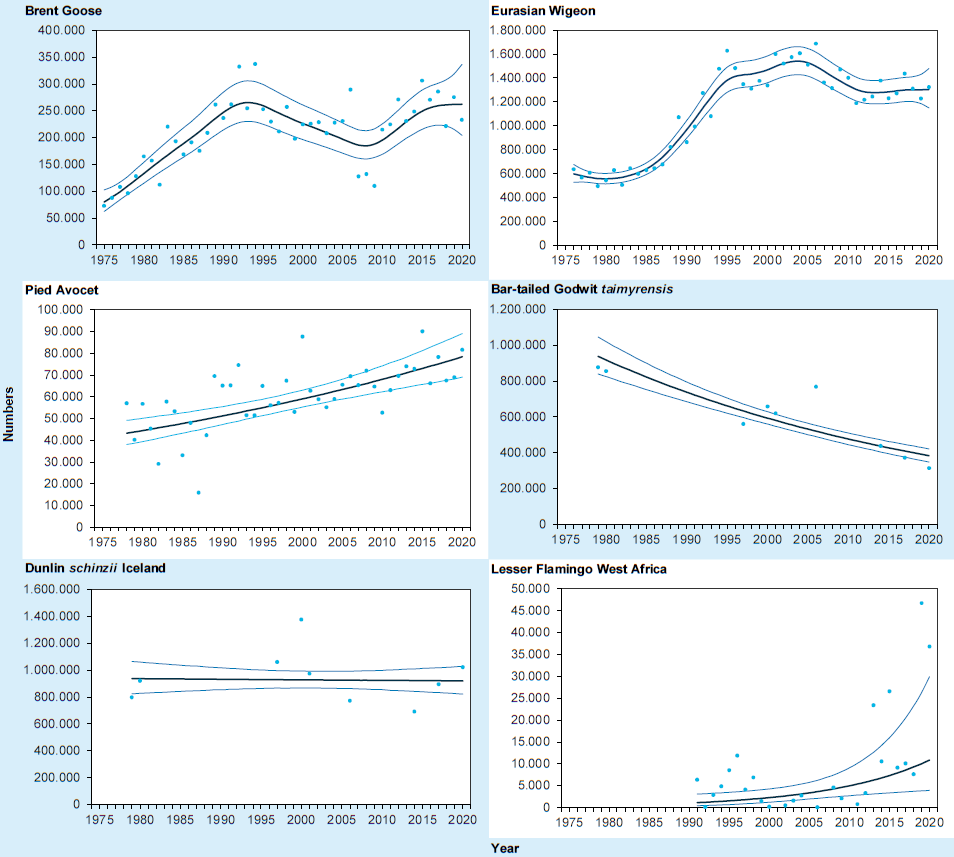 Figure 2. Flyway population trends of Brent Goose (bernicla subspecies), Eurasian Wigeon (Northwest European wintering population), Pied Avocet (Northwest European breeding population), Bar-tailed Godwit (taimyrensis population wintering in West Africa), Dunlin (schinzii breeding population from Iceland) and Lesser Flamingo (breeding population in West Africa).
Figure 2. Flyway population trends of Brent Goose (bernicla subspecies), Eurasian Wigeon (Northwest European wintering population), Pied Avocet (Northwest European breeding population), Bar-tailed Godwit (taimyrensis population wintering in West Africa), Dunlin (schinzii breeding population from Iceland) and Lesser Flamingo (breeding population in West Africa).
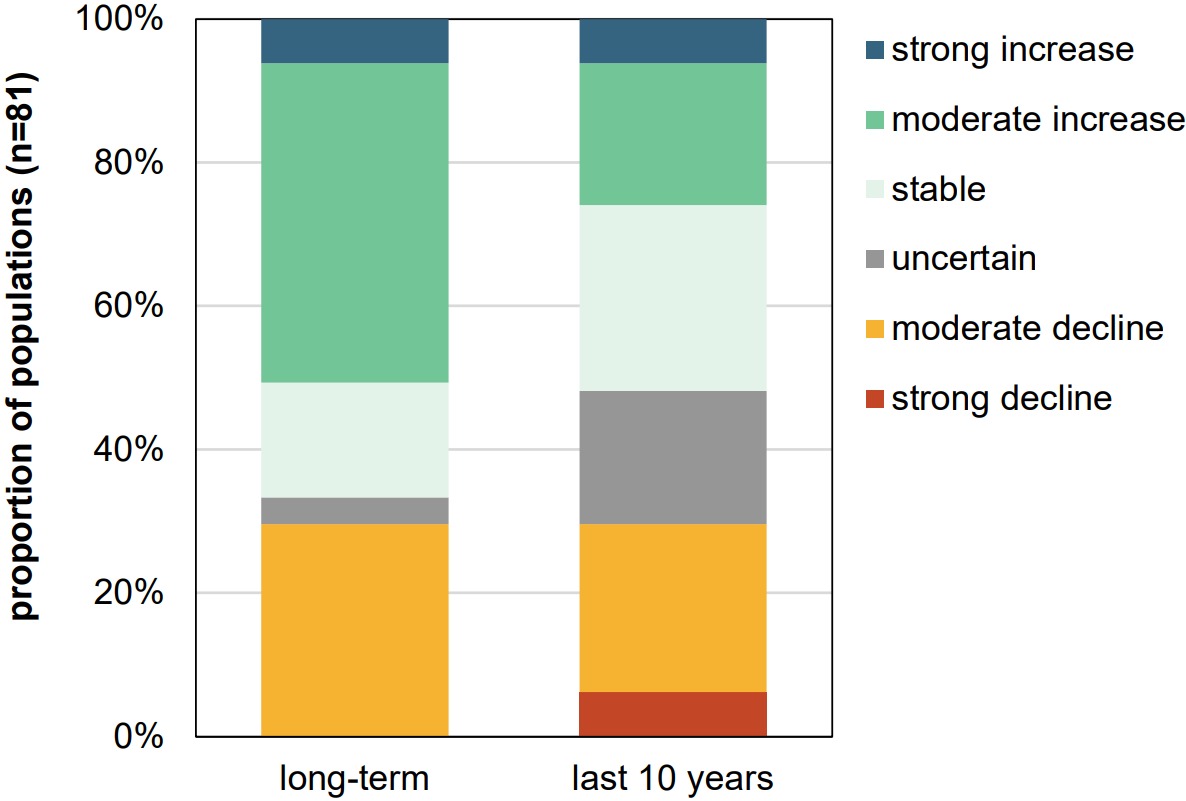 Figure 3. Proportions of increasing, stable or decreasing flyway population trends along the East Atlantic Flyway (n=81 populations), see Annex 1 for individual population results.
Figure 3. Proportions of increasing, stable or decreasing flyway population trends along the East Atlantic Flyway (n=81 populations), see Annex 1 for individual population results.
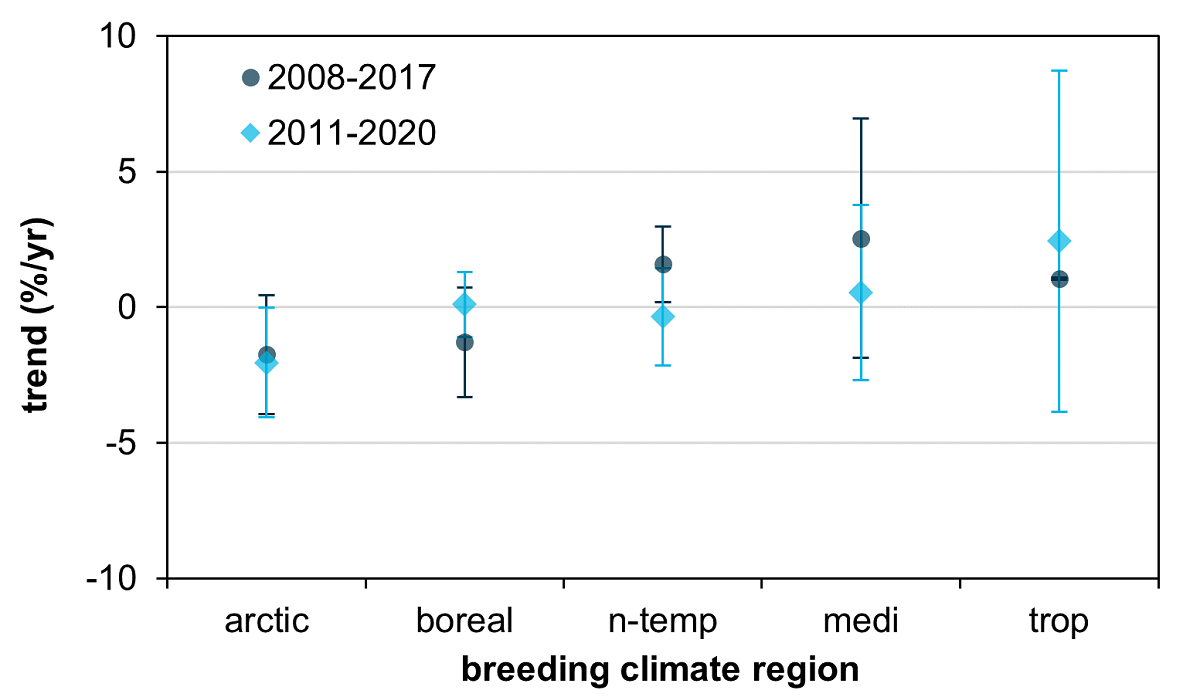 Figure 4. Average trend of flyway populations according to their breeding region (arctic, boreal, North temperate, Mediterranean or tropical). Analyses are based on the recent ten-year trends and are given for both 2008 – 2017 (from Schekkerman et al., 2018) and for 2011-2020, See Annex 1 for the assigning to breeding regions of individual populations.
Figure 4. Average trend of flyway populations according to their breeding region (arctic, boreal, North temperate, Mediterranean or tropical). Analyses are based on the recent ten-year trends and are given for both 2008 – 2017 (from Schekkerman et al., 2018) and for 2011-2020, See Annex 1 for the assigning to breeding regions of individual populations.
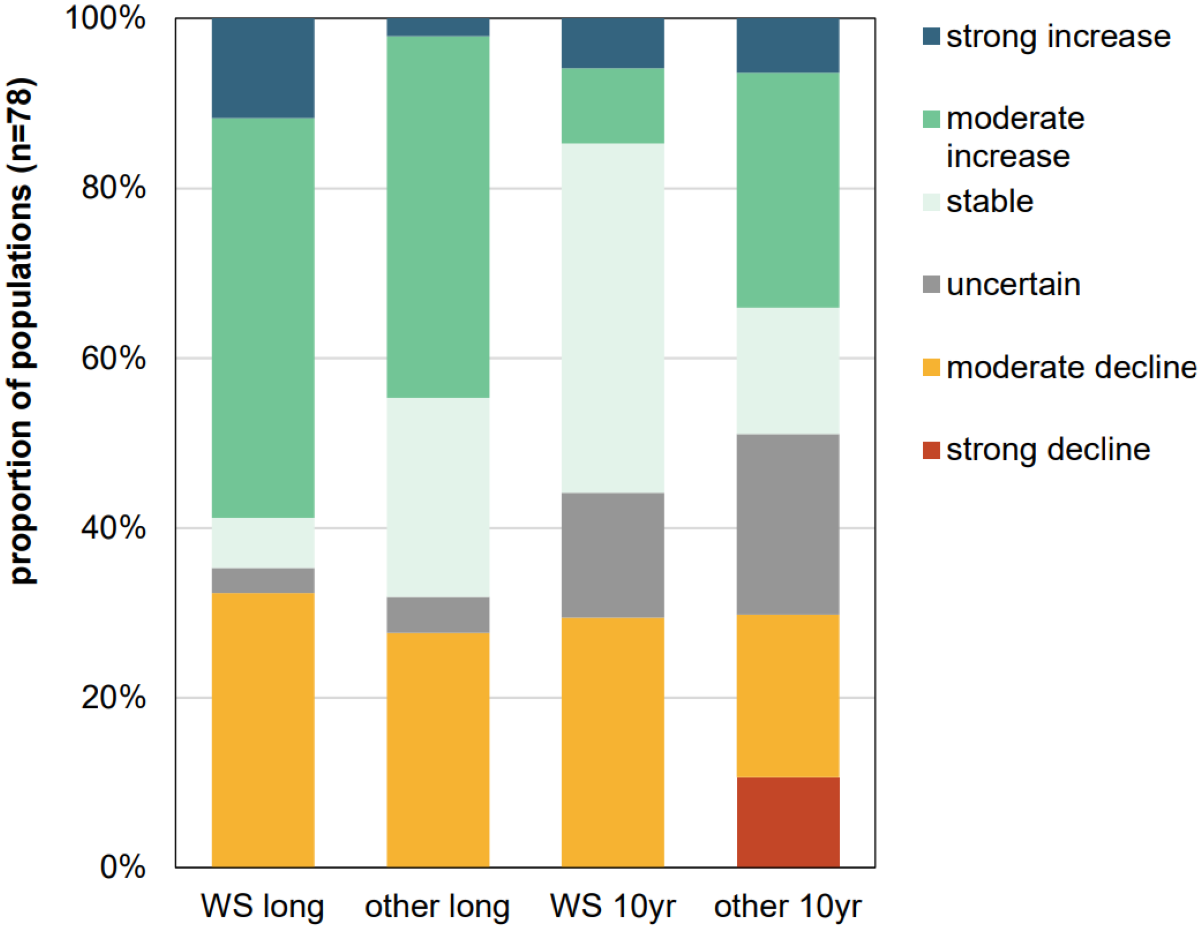 Figure 5. Proportions of increasing, stable or decreasing flyway populations of important Wadden Sea populations compared with those among other populations in the East Atlantic Flyway. Annex 1 lists which populations are important in a Wadden Sea context.
Figure 5. Proportions of increasing, stable or decreasing flyway populations of important Wadden Sea populations compared with those among other populations in the East Atlantic Flyway. Annex 1 lists which populations are important in a Wadden Sea context.
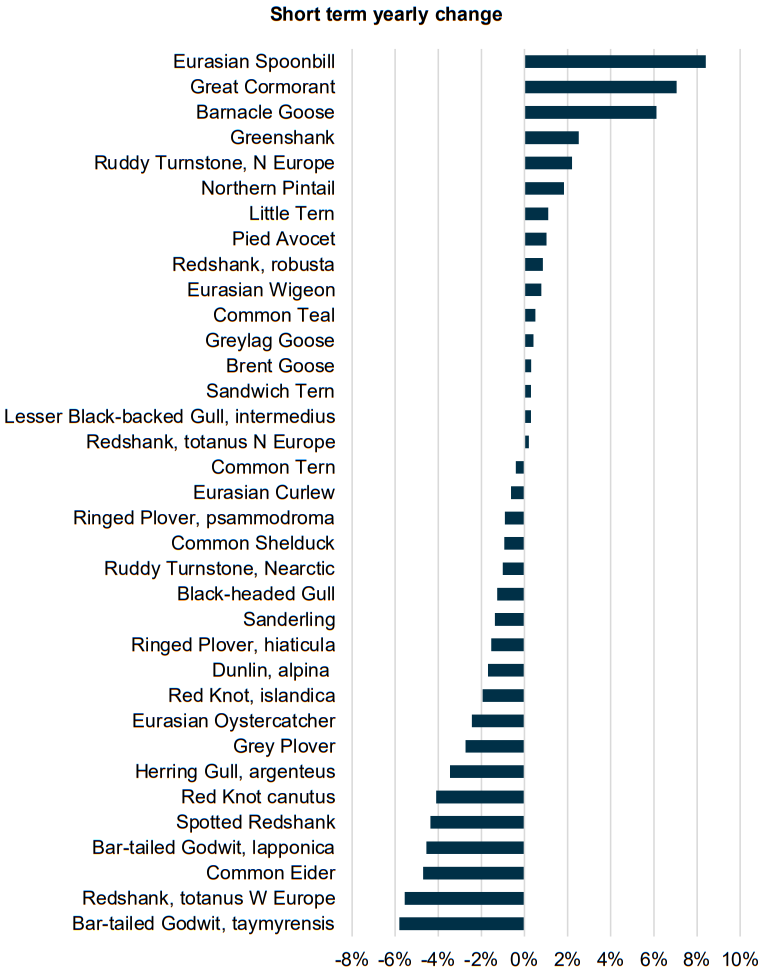 Figure 6. Annual changes in flyway populations for which the Wadden Sea is important, both in the short and the long term.
Figure 6. Annual changes in flyway populations for which the Wadden Sea is important, both in the short and the long term.
2.3. Which sites are important during winter for Wadden Sea populations?
Despite the fact that the Wadden Sea is very important for many waterbird populations, none of the populations has a distribution that is entirely confined to the Wadden Sea. They all also depend, to a larger or smaller extent, on other sites along the flyway. Figure 7 gives two examples of distributions in winter. The extent to which sites along the flyway are used during winter by flyway populations which are also important in the Wadden Sea are shown in Figure 8. The 50 most important sites are given in Annex 2 together with the number of Wadden Sea populations for which they are internationally important. Obviously, the Wadden Sea itself is an important wintering site as well. The Banc d’ Arguin in Mauritania has the highest international importance for many Wadden Sea populations, followed by the Bijagos Archipelago in Guinea-Bissau. Both in the United Kingdom and France, several sites rank among the most important sites for Wadden Sea populations during winter. Other countries with sites found among the first 50 are Morocco, Portugal, Spain, Guinea, Senegal and Sierra Leone, and to a lesser extent Ghana and Cameroon. Further south, sites that are internationally important for Wadden Sea populations are scarcer, but they do occur as far south as Namibia. Some countries may be underrepresented in this analysis because of the incompleteness of counts. This may especially be the case for sites in Nigeria and Angola. Considering how large the proportion of the flyway population size is that is found at known wintering sites, it is safe to conclude that for several populations a large proportion of their flyway population is ‘missing’ in winter. This is for instance the case in Spotted Redshank, Common Greenshank and Whimbrel. These could be present in coastal Nigeria and more inland in the Sahelian region not covered sufficiently in the present data. Common Tern and Sandwich Tern also are among the species with the lowest population proportions found at monitored sites. These species forage largely out at sea and the site counts will only cover a small part of their numbers.
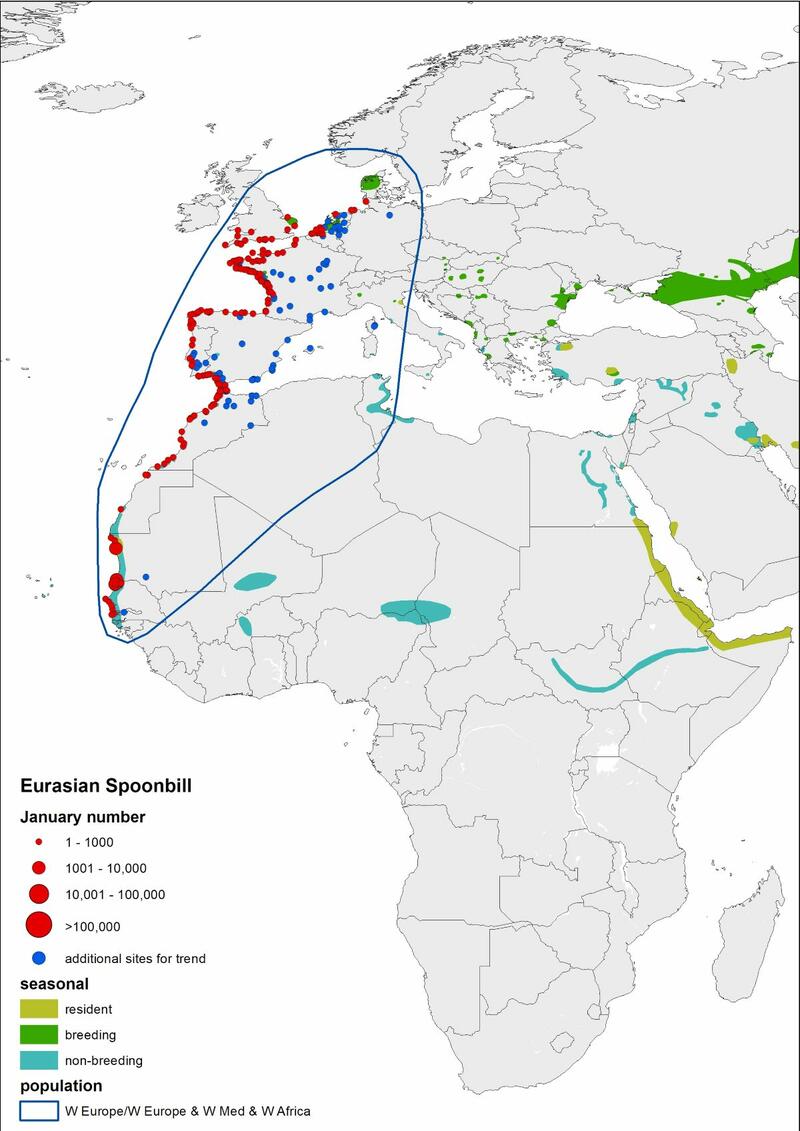
 Figure 7. Winter distribution of the East Atlantic population of the Eurasian Spoonbill (7a) and the hiaticula and psammodroma populations of the Common Ringed Plover (7b) based on January counts from 2016-2020. Missing or incomplete counts at sites have been omitted from the calculation of site averages. Red dots are sites on the coastal East Atlantic Flyway, blue dots are more inland sites also used by the same population.
Figure 7. Winter distribution of the East Atlantic population of the Eurasian Spoonbill (7a) and the hiaticula and psammodroma populations of the Common Ringed Plover (7b) based on January counts from 2016-2020. Missing or incomplete counts at sites have been omitted from the calculation of site averages. Red dots are sites on the coastal East Atlantic Flyway, blue dots are more inland sites also used by the same population.
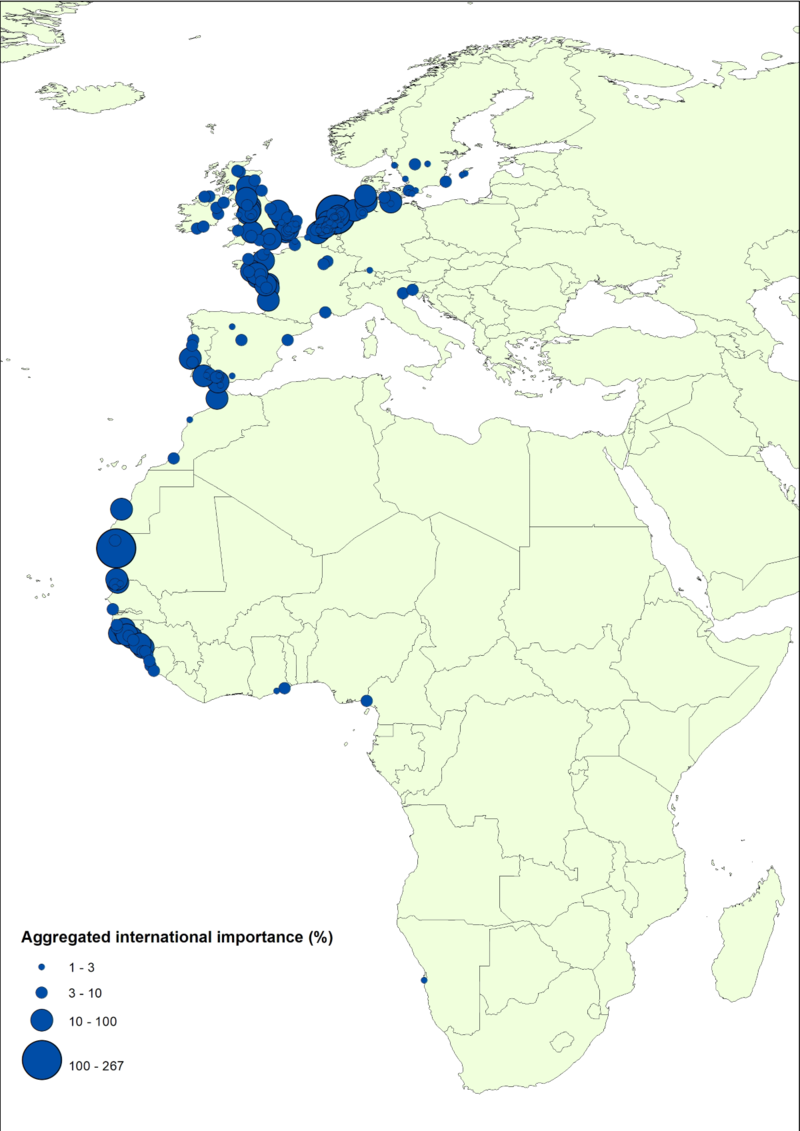
Figure 8. The aggregated international importance of sites during winter for important Wadden Sea populations. Sites are shown when they harbour at least 1% of a flyway population for which the Wadden Sea is of major importance. The size of the dots reflects the combined aggregated importance for all Wadden Sea important populations occurring at the site. Annex 2 lists the 50 sites with the highest aggregated international importance.
2.4 Which pressures affect Wadden Sea populations along the Flyway?
Based on the questionnaires, many pressures have been identified at the surveyed sites along the East Atlantic Flyway. Based on the combined scores for each pressure and the frequency of these scores across the 115 sites along the flyway, a ranking can be made among these pressures (Figure 9). Fisheries (including shellfish taking) and recreation and tourism are often mentioned as pressures negatively affecting sites. Also, farming, together with its use of chemicals and fertilizers, ranks high on the list. In addition, ship traffic, encroachment of housing, and garbage and litter are often mentioned. Military exercises, wind farms and oil and gas exploitation can have a high local impact but because they occur at only a few sites, they ranked low. Wind farms are usually present in the vicinity of sites but not within the sites themselves. Furthermore, wind farms are more often mentioned in Europe than in Africa. Similar differences in distribution are found among other pressures. Figure 10 gives two examples of the distribution of threats, for farming and for forest logging and firewood collection. Farming (grazing and crops) is mentioned as a widespread pressure both in Europe and Africa. Logging and firewood collection is much more common in Africa, especially at sites with mangroves. Effects of climate change (including sea-level rise, high temperatures and extreme weather) are mentioned but these categories are often indicated as having unknown effects.
 Figure 9. Frequency distribution (%) of pressures indicated at 115 sites along the East Atlantic Flyway. Pressures are scored separately for timing, scope and severity, after which summed scores are summarized into four categories (high prevalence, low prevalence, absent or prevalence unknown).
Figure 9. Frequency distribution (%) of pressures indicated at 115 sites along the East Atlantic Flyway. Pressures are scored separately for timing, scope and severity, after which summed scores are summarized into four categories (high prevalence, low prevalence, absent or prevalence unknown).
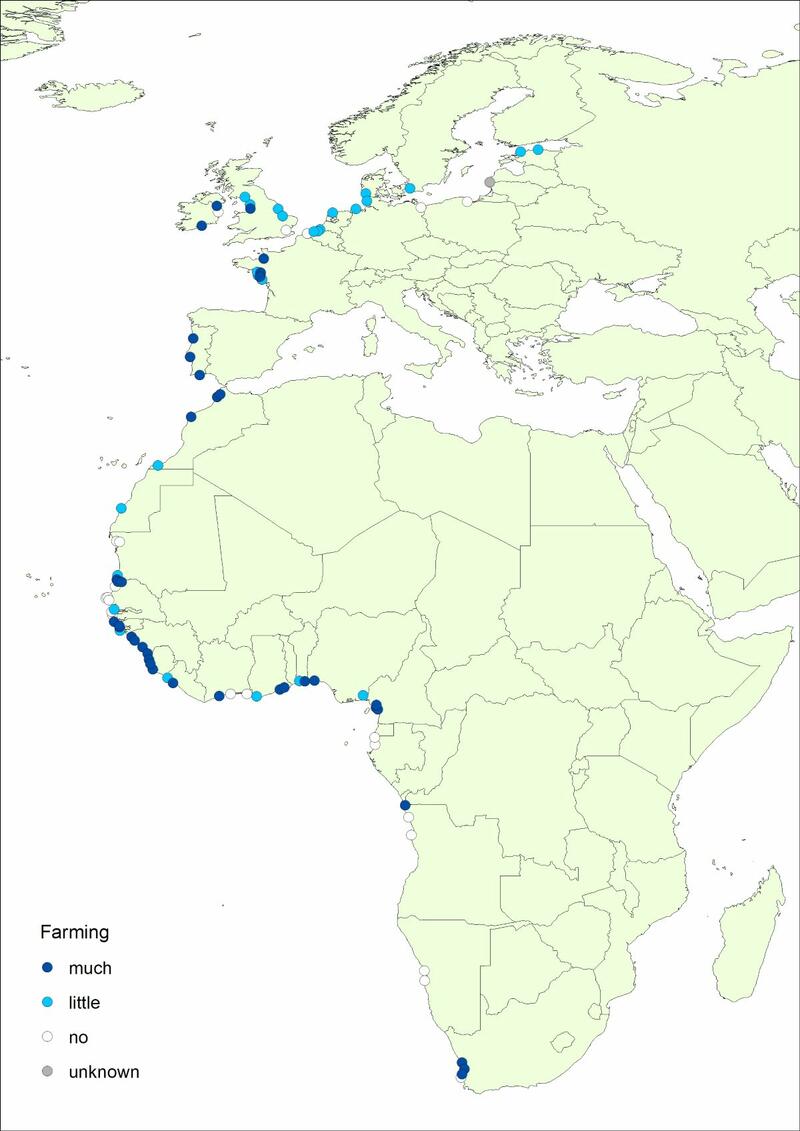
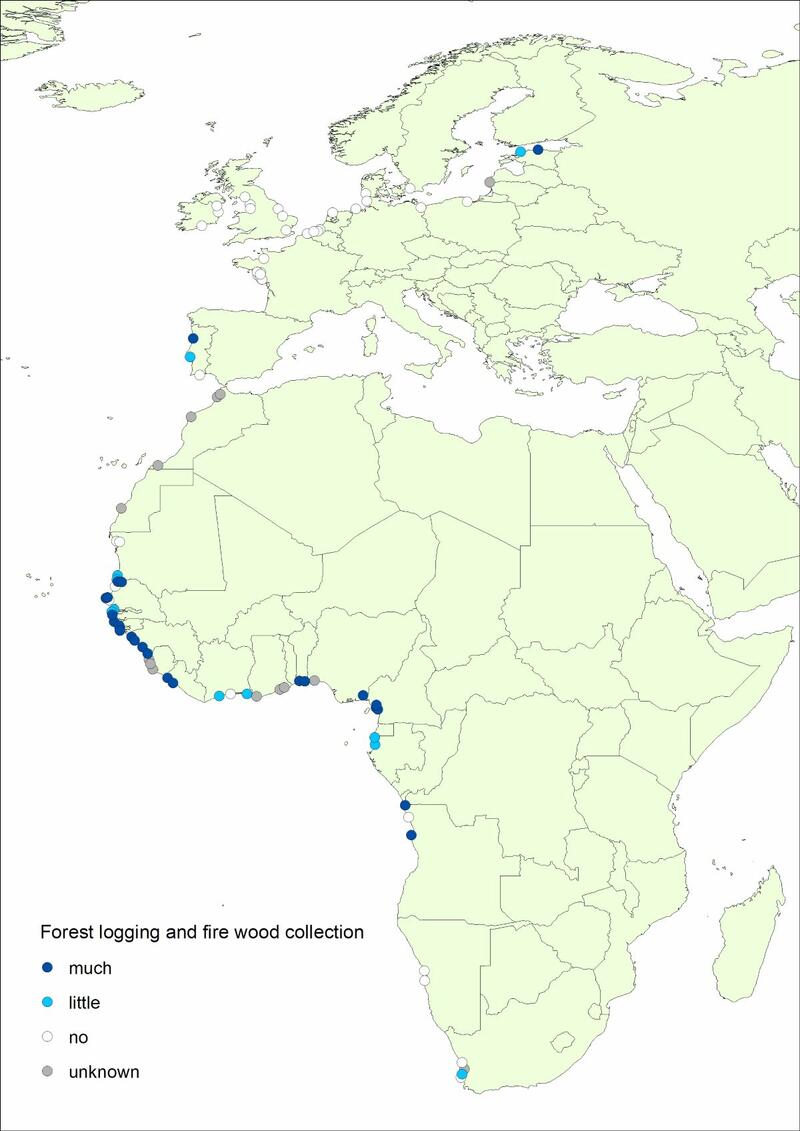 Figure 10. Occurrence of farming (to the left) and forest logging and firewood collection (to the right) as pressures at 115 sites along the flyway.
Figure 10. Occurrence of farming (to the left) and forest logging and firewood collection (to the right) as pressures at 115 sites along the flyway.
3. Assessment
The targets of the Wadden Sea Plan aim to maintain a favourable conservation status of all bird populations using the Wadden Sea, with abundance, breeding success and survival reflecting natural conditions. These targets are defined for the Wadden Sea area only but were extended here to the flyway populations the Wadden Sea populations belong to and all the sites they use.
Based on the results presented in this thematic report, it was concluded that:
-
The majority of flyway populations using the coastal East Atlantic Flyway are doing well, with stable or increasing population sizes. This is in strong contrast to other waterbird flyways worldwide, e.g. the West-Asian – East African Flyway (Wetlands International, 2021) and the East Asian – Australasian Flyway (MacKinnon et al., 2012; Piersma et al., 2016).
-
On average, flyway populations for which the Wadden Sea is important are performing equally to flyway populations that are less dependent on the Wadden Sea. The assessment following the first total count in 2014 aroused concerns that the Wadden Sea formed a ‘weak link’ in the flyway, negatively affecting the trends of flyway populations that use the Wadden Sea (van Roomen et al., 2015). This pattern was not found after the current update of trends. One can only speculate about the causes, but migratory waterbirds have in general shown improved trends within the Wadden Sea (see Kleefstra et al., Migratory Birds). In contrast, negative developments still dominate among populations breeding in the Wadden Sea (see Koffijberg et al., Breeding Birds; Figure 11).
-
Despite the relatively good status of the Flyway, particularly waders migrating long distances and breeding in the Arctic show more negative trends than other taxonomic groups. Recently also Sanderling and the lapponica population of the Bar-tailed godwit started to decline.
-
Our analysis enables prioritization of conservation, research and management along the flyway with the goal to conserve bird abundance and diversity in the Wadden Sea as well. Many sites contribute to the conservation status of Wadden Sea populations during winter, migration or breeding periods. This includes also the Arctic which is a very important breeding area for many Wadden Sea birds.
-
At the sites used by Wadden Sea populations outside the breeding season, many anthropogenic pressures occur. The extent to which each of these pressures influences the conservation status along the Flyway and within the Wadden Sea cannot be indicated with the current data. However, it seems likely that pressures influence the natural conditions at each site, and thus the abundance of migratory birds using a site. Further research is needed to determine how exactly they may influence the conservation status of populations along the flyway.
-
The current East Atlantic Flyway assessment confirms that one of the Outstanding Universal Values, still holds, namely that the Wadden Sea is one of the most important areas for migratory birds and is connected to other key sites for these migratory birds on the Northern and Southern hemispheres (Reise et al., 2010).
 Figure 11. Proportions of increasing, stable or decreasing trends, both long term and during recent 10 years, within the East Atlantic Flyway (based on this study), for migrating and wintering populations within the Wadden Sea (based on Kleefstra et al., 2022, thematic report Migratory Birds) and for breeding populations within the Wadden Sea (based on Koffijberg et al., 2022, thematic report Breeding Birds).
Figure 11. Proportions of increasing, stable or decreasing trends, both long term and during recent 10 years, within the East Atlantic Flyway (based on this study), for migrating and wintering populations within the Wadden Sea (based on Kleefstra et al., 2022, thematic report Migratory Birds) and for breeding populations within the Wadden Sea (based on Koffijberg et al., 2022, thematic report Breeding Birds).
4. Recommendations
Recommendations for monitoring & research
-
With the current monitoring effort in the East Atlantic Flyway, it is possible to update flyway trends for the Wadden Sea important populations and other populations and signal pressures at the sites they use on a regular basis. To maintain the current level of cooperation and information it will be important to continue the monitoring at the flyway scale.
-
Despite the increasing availability of data collected, these data are still not collected routinely and with sufficiently good quality along the flyway. Particularly in many African countries, capacity and resources substantially limit the potential of countries to carry out and finance the monitoring independently. Continued and increased capacity building is needed as well as options for structural funding within the countries themselves.
-
In addition to winter counts, breeding bird monitoring is important for assessing information on flyway trends and population sizes, as a selection of populations is easier and better monitored in the breeding season. Current large-scale international breeding bird monitoring programs need to be maintained. Improvements are recommended for the yearly collection of data for colony-breeding waterbird species, both in Europe and in West and South Africa.
-
For some flyway populations, limited information exists about their flyway boundaries and the connectivity between breeding, stop-over and wintering sites. This influences the accuracy of flyway population trends and sizes and limits the effectiveness of a year-round flyway conservation strategy. Recent developments in the tracking technology of individual birds could considerably improve this knowledge.
-
With the current questionnaires on human uses and pressures at sites, important information is collected about the types and distribution along the flyway. However, the information collected is not quantitative and sometimes difficult to assess properly by observers. It is recommended that data should also be collected, and regular monitoring started, using information from remote sensing to detect changes in habitat availability and the different human uses at sites. Besides, more research is needed to quantify the real impact of the pressures on the population numbers by assessing their influence on reproduction and survival.
-
The current level of information is dominated by the mid-winter situation in January. It will be important for conservation and management to also collect flyway-wide information during migration periods. This can reveal new important sites only used during migration and pinpoint to further local pressures during migration that may affect the populations’ conservation status.
-
As many of the populations using the flyway are breeding in the Arctic and these populations relatively often show decreasing trends, the monitoring of breeding conditions (snow cover, vegetation development, predation, breeding success) in the Arctic is a high priority. Because of the vast area involved, careful choices need to be made about which information can be feasibly collected on a regular basis. This will most likely be a combination of remotely collected data and field research and monitoring at a small selection of field stations.
-
The results from the monitoring of the East Atlantic Flyway provide an important basis for management and conservation, but the monitoring of bird numbers is not sufficient to unravel the mechanisms behind the observed declines, nor will the monitoring be very specific in terms of pinpointing management actions for improving the conservation status. Therefore, it is important that in-depth research, including demographic monitoring and knowledge of individual birds through colour-ringing and tracking, is carried out at the flyway scale as well to identify the mechanisms behind declines and collect conservation evidence for management actions.
Recommendations for management
Within the framework of the Wadden Sea Flyway Initiative, a new eight-year action plan is under preparation by the WSFI Steering group. It will include specific work packages with recommendations for projects improving cooperation and coordination, organizational aspects, wise use and management of coastal resources, strengthening policies and legislation, capacity for conservation and management and building awareness. It is recommended that dedicated actions be taken by all WSFI partners and collaborators to implement this new action plan and its work packages.
5 Summary
As birds using the Wadden Sea are part of flyway populations that rely on a larger network of sites, knowledge from the entire flyway is needed for the effective conservation of these bird populations. The birds in the Wadden Sea belong to the East Atlantic Flyway which stretches from Northeast Canada to Northern Siberia in Russia and southward along the coastlines of the Baltic Sea, North Sea and Eastern Atlantic Ocean all the way to South Africa. The monitoring along this flyway received a new impulse when the Wadden Sea was granted World Heritage Status. The Wadden Sea Flyway Initiative started an integrated monitoring programme together with Wetlands International and BirdLife International. Within this programme, censuses have been conducted annually in Western Africa from 2013 onwards and total mid-winter counts along the entire flyway have taken place with an interval of three years, in 2014, 2017, and 2020. In addition to the assessment of trends in bird abundance, also the assessment of pressures occurring at the different sites along the flyway is part of this monitoring. Thanks to this programme flyway trends for 81 populations of 67 species have been documented, based on bird counts at 1000s of count sites. Environmental data including scores of the presence of pressures have been collated from 115 coastal sites in both Africa and Europe.
The majority of flyway trends are stable or increasing. Compared with some other waterbird flyways worldwide, bird populations using the East Atlantic Flyway are in a good condition. Nevertheless, many Arctic-breeding and long-distance migratory waders are decreasing. While earlier analyses suggested that flyway populations dependent on the Wadden Sea were relatively often declining compared with populations that depend less on the Wadden Sea, this pattern was no longer present. This may indicate that the conditions for migratory birds in the Wadden Sea have improved. Indeed, within the Wadden Sea more positive trends are found for migrants (see Kleefstra et al., Migratory Birds), although bird populations breeding in the Wadden Sea generally still show negative trends (see Koffijberg et al., Breeding Birds). During winter many of the populations for which the Wadden Sea is important during part of the year concentrate in relatively few sites along the East Atlantic Flyway. In addition to the Wadden Sea, coastal sites in Mauritania, Guinea Bissau, United Kingdom, France, Morocco, Portugal, Spain, Guinea, Senegal and Sierra Leone are important for Wadden Sea birds, but some internationally important wintering sites are found as far south as Namibia. Many pressures occur at the sites along the East Atlantic Flyway. Effects of fishing, disturbance by tourism, agricultural use and encroachment by buildings are the most frequently listed pressures. Effects of climate change (sea-level rise, warming, extreme weather) are more frequently mentioned than in the past, but their effects are often still listed as unknown. For conservation and management, it will be important not only to understand these effects better but also to find ways for mitigation and compensation (Reneerkens, 2020).
About the authorsvan Roomen, M.1, Agblonon, G.2, Citegetse, G.3, Crowe, O.3, Langendoen, T.2, Nagy, S.2, Schekkerman, H.1, van Winden, E.1
1Sovon, Dutch Centre for Field Ornithology, Toernooiveld 1, 6525 ED Nijmegen, NL 2Wetlands International, P.O. Box 471, 6700 AL Wageningen, NL 3BirdLife International, The David Attenborough Building, Pembroke Street, Cambridge, CB2 3QZ, UK |
AcknowledgementsCounts of waterbirds in the flyway are carried out by a large number of birdwatchers, rangers of nature reserves, field staff of research institutes and conservation and management agencies, both governmental and non-governmental. For the total count of January 2020, it was estimated that 13,000 observers were involved. Each country is coordinated by a national coordinator. We thank them all. We also acknowledge the various sources of national and international funding that contribute to the continuation of the International Waterbird Census and the different breeding bird monitoring projects. The flyway coordination and support of the total count 2020 was funded by the Dutch Ministry of Agriculture, Nature and Food Quality with additional co-funding from National Park Wattenmeer Niedersachsen, National Park Schleswig-Holsteinisches Wattenmeer, the Government of Denmark, MAVA and Birdlife the Netherlands. Writing of this QSR thematic report was funded by the Dutch Ministry of Agriculture, Nature and Food Quality. Comments on this report were received from Thomas Bregnballe, Jeroen Reneerkens, Sascha Klöpper and Kristine Meise which improved the content substantially. |
References
BirdLife International 2006. Monitoring Important Bird Areas: a global framework. Version 1.2. BirdLife International, Cambridge, UK.
BirdLife International 2021. European Red List of Birds. Luxembourg: Publications Office of the European Union.
Brlík, V. et al. 2021. Long-term and large-scale multispecies dataset tracking population changes of common European breeding birds. Scientific Data 8, 21.
European Goose Management Platform 2021. Population Status and Assessment Report 2021. EGMP Technical Report No. 19 Bonn, Germany.
Harebottle, D.M., & Underhill, L.G. 2016. Assessing the value of wetlands to waterbirds: exploring a population-based index at flyway and regional levels. Ostrich 87, 1-15.
Kleefstra, R., Bregnballe, T., Frikke, J., Günther, K., Hälterlein, B., Hansen, M. B., Hornman, M., Meyer, J., & Scheiffarth, G. (2022). Wadden Sea Quality Status Report: Migratory birds. Common Wadden Sea Secretariat. https://doi.org/10.5281/zenodo.15224234
van Kleunen A., Nsabagasani C., Citegetse G., Dodman T., & van Roomen M (2018). Environmental monitoring of the East Atlantic Flyway 2017. In van Roomen M., Nagy S., Citegetse G. & Schekkerman H. 2018 (eds). East Atlantic Flyway Assessment 2017: the status of coastal waterbird populations and their sites. Wadden Sea Flyway Initiative p/a CWSS, Wilhelmshaven, Germany, Wetlands International, Wageningen, The Netherlands, BirdLife International, Cambridge, United Kingdom.
Koffijberg, K., Bregnballe, T., Frikke, J., Hälterlein, B., Bentzon Hansen, M., Meyer, J., Reichert, G., Umland, J., & van der Meij, T. (2022). Wadden Sea Quality Status Report: Breeding birds. Common Wadden Sea Secretariat. https://doi.org/10.5281/zenodo.15221101
MacKinnon J., Verkuil Y. I. & Murray N. 2012. IUCN situation analysis on East and Southeast Asian Intertidal Habitats, with particular reference to the Yellow Sea. IUCN, Gland, Switzerland.
Nagy, S., & Langendoen, T. 2020. Flyway trend analyses based on data from the African Eurasian Waterbird Census from the period of 1967-2018. Summary. Wetlands International. http://iwc.wetlands.org/static/files/IWC-trend-analysis-report-2020.pdf
Nagy, S., Crowe, O., & van Roomen, M. (2021). Draft monitoring priorities for waterbird species and populations of AEWA. Bonn: UNEP/AEWA Secretariat, Retrieved from https://www.unep-aewa.org/en/document/draft-monitoring-priorities-water….
Piersma, T., Lok, T., Chen N, Y., Hassell, C.J., Yang, H.-Y., Boyle, A. et al. (2016) Simultaneous declines in summer survival of three shorebird species signals a flyway at risk. Journal of Applied Ecology, 53, 479-490.
Reise, K., Baptist, M., Burbridge, P. et al. 2010: The Wadden Sea – A universally outstanding tidal wetland. Wadden Sea Ecosystem 29: 723. Common Wadden Sea Secretariat, Wilhelmshaven, Germany.
Reneerkens, J. (2020). Climate change effects on Wadden Sea birds along the East Atlantic Flyway. Position paper 2020-2 Wadden Academy.
van Roomen M., Citegetse G., Crowe O., Dodman T., Hagemeijer W., Meise K., & Schekkerman H. 2022 (eds). East Atlantic Flyway Assessment 2020.The status of coastal waterbird populations and their sites. Wadden Sea Flyway Initiative p/a CWSS, Wilhelmshaven, Germany, Wetlands International, Wageningen, The Netherlands, BirdLife International, Cambridge, United Kingdom.
van Roomen M., Delany S. & Schekkerman H. 2015, 2018, 2022. Integrated monitoring of coastal waterbird populations along the East Atlantic Flyway. Framework and programme outline for Wadden Sea and other populations. Programme Rich Wadden Sea, Leeuwarden, The Netherlands and Common Wadden Sea Secretariat, Wilhelmshaven, Germany.
van Roomen M., Nagy S., Foppen R., Dodman T., Citegetse G. & Ndiaye A. 2015. Status of coastal waterbird populations in the East Atlantic Flyway, with special attention to flyway populations making use of the Wadden Sea. Programme Rich Wadden Sea, Sovon, Wetlands International, BirdLife International, & Common Wadden Sea Secretariat, Leeuwarden.
van Roomen, M., van Turnhout, C., Blew, J., Koffijberg, K., Nagy, S., Citegetse, G., & Foppen, R. (2017). Wadden Sea Quality Status Report: East Atlantic Flyway. Common Wadden Sea Secretariat. https://doi.org/10.5281/zenodo.15221429
van Roomen M., Nagy S., Citegetse G. & Schekkerman H. 2018 (eds). East Atlantic Flyway Assessment 2017: the status of coastal waterbird populations and their sites. Wadden Sea Flyway Initiative p/a CWSS, Wilhelmshaven, Germany, Wetlands International, Wageningen, The Netherlands, BirdLife International, Cambridge, United Kingdom.
Schekkerman H., Gueye Fall K., Nagy S., & van Roomen M., 2018. Patterns in trends of waterbird populations using the coastal East Atlantic Flyway, update 2017. In van Roomen M., Nagy S., Citegetse G. & Schekkerman H. 2018 (eds). East Atlantic Flyway Assessment 2017: the status of coastal waterbird populations and their sites. Wadden Sea Flyway Initiative p/a CWSS, Wilhelmshaven, Germany, Wetlands International, Wageningen, The Netherlands, BirdLife International, Cambridge, United Kingdom.
Soldaat L., Visser H., van Roomen M. & van Strien A. 2007. Smoothing and trend detection in waterbird monitoring data using structural time-series analysis and the Kalman filter. Journal of Ornithology 148: 351-357.
Wetlands International 2021. Population size and trend estimates for the 8th edition of the AEWA conservation status report. Wetlands International. http://wpe.wetlands.org/
Wildfowl & Wetlands Trust 2021. Goose & Swan Monitoring Programme. WWT/JNCC/NatureScot, Slimbridge. retrieved from https://www.wwt.org.uk/
This report should be cited as: van Roomen, M., Agblonon, G., Citegetse, G., Crowe, O., Langendoen, T., Nagy, S., Schekkerman, H., & van Winden, E. (2022). Wadden Sea Quality Status Report: East Atlantic Flyway. Common Wadden Sea Secretariat. https://doi.org/10.5281/zenodo.15221331
All 2022 reports may be cited collectively as: Kloepper, S., Bostelmann, A., Bregnballe, T., Busch, J.A., Buschbaum, C., Deen, K., Domnick, A., Gutow, L., Jensen, K., Jepsen, N., Luna, S., Meise, K., Teilmann, J., & van Wezel, A. (2022). Wadden Sea Quality Status Report. Common Wadden Sea Secretariat, Wilhelmshaven, Germany. Downloaded DD.MM.YYYY. qsr.waddensea-worldheritage.org
